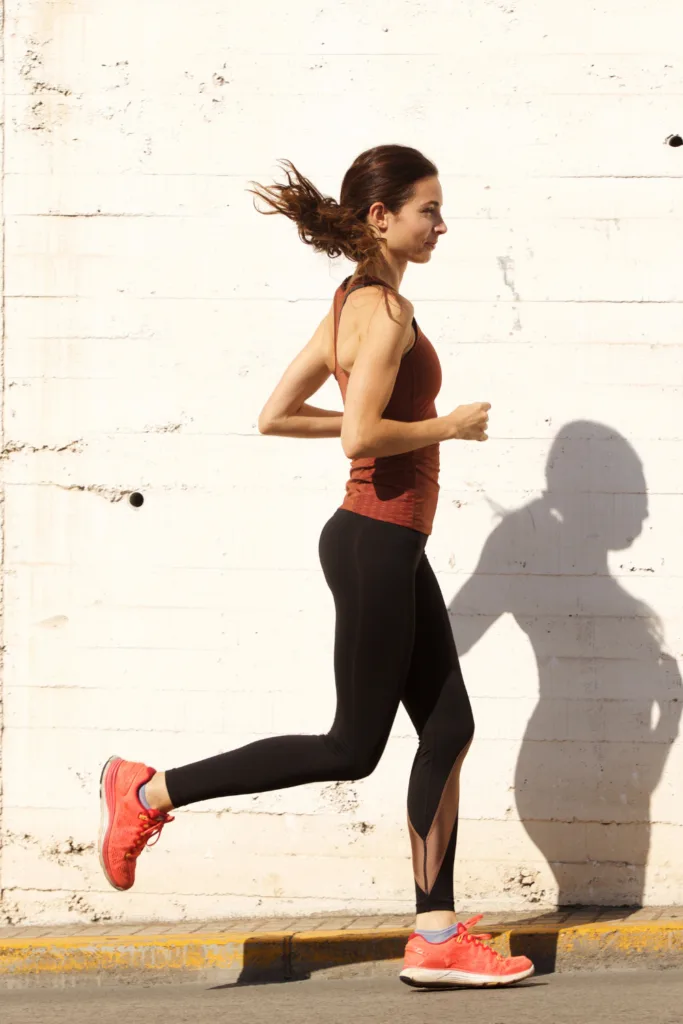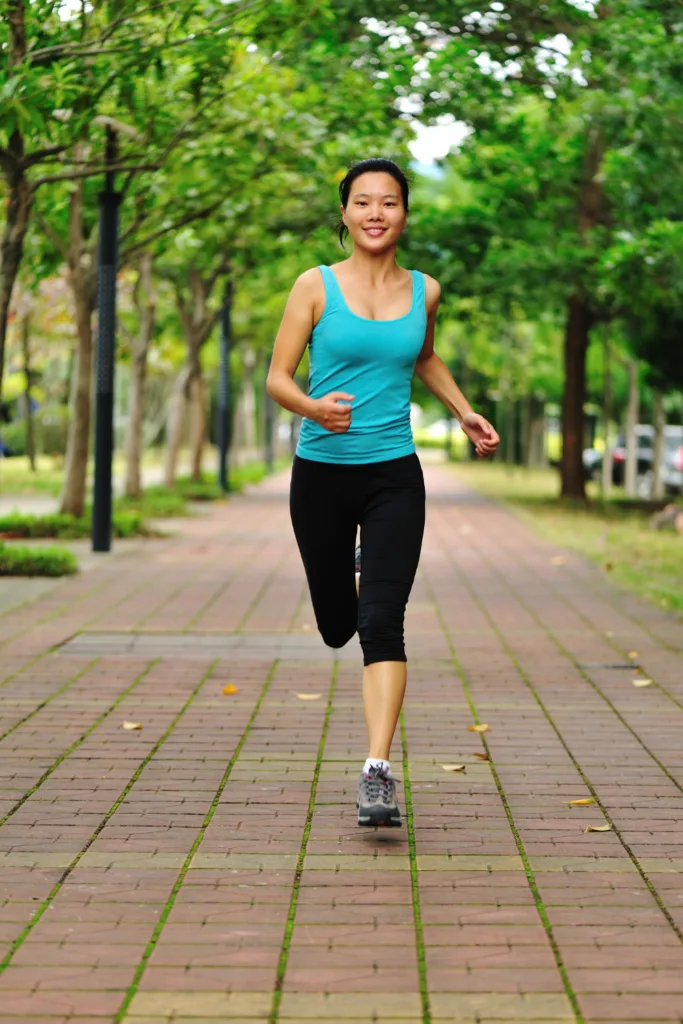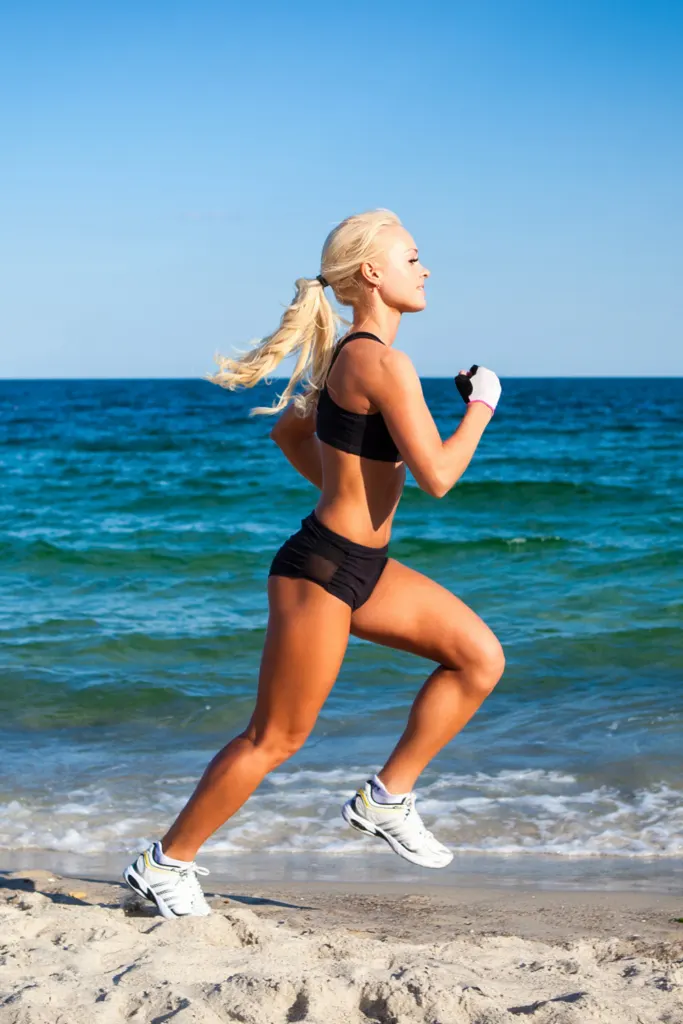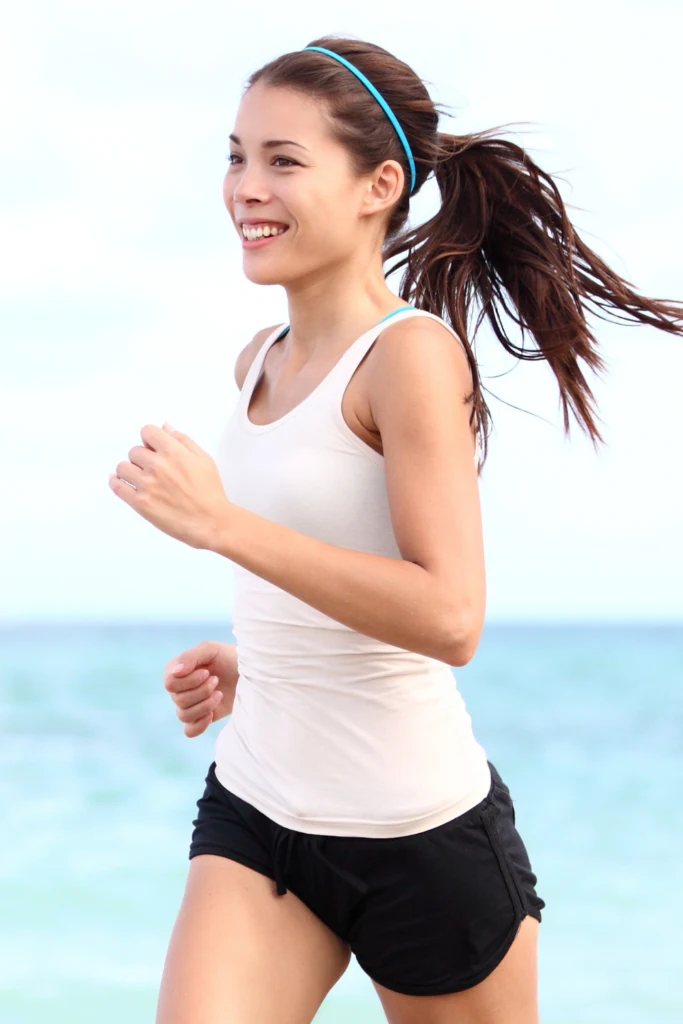What muscles does running work?
Running is a total body exercise. You work more than just your lower leg muscles when you run.
The muscles in your legs, core and upper body work together to move your body forward during a run.
If there are any imbalances in your muscles, or you adopt a poor running form, this can cause running injuries like IT band syndrome, runner’s knee and shin splints.
Unfortunately the injury rate in the running community is still quite high.
This is why it’s important to know about the key running muscles, how they are used during running and how to strengthen them effectively.
In this guide we’ll explore:
- What muscles does running work?
- Muscles worked during running
- What muscles does running uphill work?
- What muscles does running backwards work?
- 5 ways to prevent common running injuries
Ready?
Let’s get going!

What muscles does running work?
Running is a form of aerobic exercise so it works multiple muscle groups in the body.
There are over 650 named skeletal muscles in the human body and they all work to perform different functions in the body.
Skeletal muscles (muscles attached to your bone and tendons) enable movement, maintain posture, provide structural support and help to maintain body temperature.
During running, your muscles perform the following roles:
- Shock absorption and control (running is a weight bearing exercise).
- Balance and posture control in the upper body.
- Energy generation to propel the body forward and upward.
- Control of direction changes of the centre of mass of the body.
Your leg muscles do the bulk of the work – your hamstrings, hip flexors, glutes, quadriceps, adductors and calf muscles all work together to propel your body forward.
Muscles in your core and upper body are used to keep you stable and upright when running.
Lastly, your arms are also crucial to help dictate the pace of your run.
Related: 7 of the best glute strength exercises for runners

Related: 6 of the best supplements for runners
Muscles worked during running
Here is a list of the main muscles that are used during running:
#1 Glutes
Your glutes refer to the group of muscles in your buttocks.
They help to extend your leg forward at the hip when you run and propel your body forward.
One of these muscles – the gluteus maximus – is the biggest muscle in the body.
All of the muscles in the glutes are worked during running.
They work together with other muscles in the body to maintain alignment between the hips, knees and feet and stabilise your hips, pelvis and core when you run.
Glute weakness is a major cause of injury and muscle imbalance in the running community.
Weak glutes can also impact your running form and running stride.
#2 Quadriceps
Also known as ‘quads’ for short, your quadriceps are a group of muscles in the front of your thigh above the knee.
These muscles work together to flex the leg at the hip, extend the knee and stabilise the knee when you run.
Their key function is to support your body weight when you run and prevent the knee from buckling when you land your foot on the ground.
If you do a lot of downhill running, you may experience sore quadriceps.
This is because your quads lengthen during your running stride when you land your foot on the ground.
The quads work in opposition to the hamstrings at the back of the leg which I’ll look at next.
#3 Hamstrings
Like the glutes, the hamstrings are one of the main muscle groups used when running.
The hamstrings are a group of muscles at the back of your thigh.
They work in opposition to the quadricep muscles on the front of your thigh.
Your hamstrings play an important role to drive your leg forward up into the air which pushes and propels you forward when you run.
#4 Hip flexors
The hip flexors are often neglected, but they are key running muscles that are found along the front of the hip and pelvis.
They work together to flex the hip and drive your leg forward during your run.
As such, they are key muscles for forward movement.
#5 Core
Your core is extremely important when running as it helps to stabilise your body when you run.
Core muscles include all of the muscles that help support your trunk and maintain proper pelvic, hip and spine positioning and posture.
They also help protect the spine by absorbing some of the shock and impact when your foot hits the ground.
A weak core can lead to muscle imbalances and injury.
It can also affect your running form and posture and even impact your breathing.
#6 Calves
Your calves are found behind your lower leg and run from the back of the knee down to the Achilles tendon.
The calves help to flex the knee and ankle.
They also perform two opposing roles:
- They work to decelerate your leg when your foot hits the ground when you run.
- They help to propel your leg forward when you drive your leg up and off the ground.
Many runners suffer with tight calf muscles if they have a forefoot strike pattern.
Tight calf muscles can also be caused by flat feet and wearing minimalist running shoes.
#7 Upper body
That’s right, running is not just a lower body exercise!
Muscles in your upper body (arms, shoulders, chest, upper back) are used to maintain an upright posture and swing your arms when you run.
Your arm swing works to propel your body forward and helps to dictate running speed.
Your arms also help balance and stabilise your body.
Related: 9 of the best shin splint stretches for runners

What muscles does running uphill work?
What muscles does running work during a hill sprint workout?
If you regularly run up hills or include hill sprints as part of your training routine, you’ll know how physically demanding they can be!
Running uphill builds endurance and strength and targets the same muscles but at a greater intensity.
This is because your muscles must work harder to effectively propel your body up the hill.
You will find that running uphill is a more effective way to build muscle strength as opposed to running on flat terrains alone.
Running uphill is also a great way to work on your arm swing and running form.
This is why hill sprints are often recommended to runners looking to build strength and explosive power.
If you don’t live near hills, then running on a treadmill at an incline is equally as effective.
Running uphill works the following muscles:
- Calves
- Quadriceps
- Hamstrings
- Hip flexors
- Glutes
- Upper body
Related: 3 hill sprint workouts to increase strength and power
What muscles does running backwards work?
What muscles does running work when you run backwards?
Running backwards is a good way to challenge your muscles in new and creative ways.
If you’re only ever used to running forwards, then you may find running backwards challenging at first.
However if you keep with it, you’ll find that the following muscles are used more and therefore become stronger:
- Glutes
- Hamstrings
Your quadriceps and calf muscles are also used but to a lesser extent.
Studies have shown that the way in which muscles contract when running backwards is likely to make them stronger.
This means your muscles can cope with applying more force for longer, therefore you are able to run faster for longer.
So if you’re looking to run a personal best, running backwards may be an option for you.
Related: 7 best hip strengthening exercises for runners + how to do them

5 tips to prevent common running injuries
Injuries like shin splints, runner’s knee and IT band syndrome are common running injuries.
Here are 5 tips to stay injury free for longer:
#1 Perfect your form
Running form and technique is all about running in the most efficient and economical way possible.
This means placing as little stress as possible on your muscles and joints.
There are five key principles when it comes to proper running form and technique:
- Posture
- Arm swing
- Core strength
- Cadence
- Footstrike
Read our complete guide to running form and technique for more information and tips.
#2 Strength train
As I mentioned earlier in this guide, the muscles in your lower body are the powerhouses in running.
Your glutes and hip flexors in particular can be seen as the ying and yang of power when running.
Try and include hip strengthening exercises and glute strengthening exercises in your training routine, either as part of a dynamic warm up or in between runs.
Some good glute strengthening exercises include squats, single-leg hip bridge, clams and resistance band monster walks.
It’s also a good idea to include glute activation drills such as fast feet in your warm up.
Glute activation exercises like this will help prepare and engage your muscles for the run ahead.
Hip flexor stretches like low lunges, reverse pigeon and forward bends are great to release tightness in your hips.
With this advice, hopefully you won’t be left wondering why you keep getting injured when running.

#3 Wear the right running shoes
Finding the right running shoes is very much a process of trial and error.
But wearing the right running shoes is essential to stay injury free for longer.
All good running shoe shops will offer a free gait analysis.
This is where they get you to run on a treadmill for a few minutes so they can assess your gait and footstrike (how you run and how your foot lands on the floor).
Depending on how you run, they will be able to find shoes right for your feet.
#4 Build your mileage slowly
Avoid sudden increases in intensity, frequency and duration in your training plan.
Many overuse injuries, like shin splints, are caused by doing too much too soon.
Follow a training plan and stick to it. Don’t be tempted to run extra miles each week.
As long as you leave adequate time to do your training plan, you should have plenty of time in which to achieve your goal.
#5 Listen to your body
Listen to your body and really try and focus on what it is telling you.
If you have a gut feeling that today is not the day for that long run, then listen to your gut.
Usually, signs of an overuse injury start as a whisper. Don’t ignore it before it’s too late!
Tune into your body and muscles and ask yourself: “How do your legs feel?” “How do your feet feel?” “How strong do you feel?”
If you start to feel a niggling pain, take a step back and assess where it could be coming from and what you could do to minimise this pain before it gets worse.
Listening to your body also means spending adequate time for rest and recovery.
Rest and recovery are essential for any runner looking to stay injury free.
Many runners consider rest days lost time.
Don’t worry – you won’t lose all your running fitness in one day!
Instead, view your rest day differently. Take some time to do something other than running.
Cross training (or ‘active recovery’) activities like yoga and walking are all good examples.
Remember, you need your rest days as much as you need your long runs and speed training.
Related: Recovery after running: 5 essential recovery tips after a long run
- 5 things I wish I’d known before returning to running - March 3, 2024
- Running 20 minutes a day: Benefits + how to start - January 27, 2024
- How to run your first 2 hour half marathon - January 16, 2024
